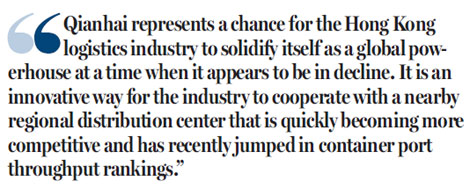Logistics industry should accept Qianhai's invitation
Updated: 2016-09-15 08:01
By Gonzalo Villalta Puig and Lauren Deutsch(HK Edition)
|
|||||||||
Gonzalo Villalta Puig and Lauren Deutsch argue that as China moves to accelerate the implementation of Belt and Road Initiative, the SAR should seize the benefits offered by the Shenzhen-HK cooperation zone in Qianhai
Easily among the most highly discussed business topics in Hong Kong is China's ambitious Belt and Road Initiative (B&R), essentially a 21st century revitalization of the ancient Silk Road. The Qianhai Shenzhen-Hong Kong Modern Service Industry Cooperation Zone, however, is much less discussed, even though it was established to accelerate the implementation of the B&R.
Qianhai is a part of the China (Guangdong) Pilot Free-Trade Zone and its purpose is to enable cooperation between Shenzhen and Hong Kong in the logistics, financial, and information technology sectors. Qianhai presents a unique opportunity for Shenzhen and Hong Kong to leverage their comparative advantage and, through the provision of superior logistics services, propel Qianhai toward the center of global supply chains. As China moves to accelerate implementation of the B&R, the Hong Kong logistics industry should view Qianhai as an easy way to get its foot in the door.
Qianhai falls directly along the path of the Maritime Silk Road, which connects China to South and Southeast Asia, the Middle East, and Europe. Hong Kong logistics companies can utilize the facilities of the Qianhai Bay Bonded Port Area to provide export consolidation, global and regional distribution, international transit, and other logistics services to countries along the B&R as well as to manage cross-border logistics for these countries, which comprise an impressive array of new markets. Hong Kong's main trading partner is the Chinese mainland, making up over 50 percent of total trade. Yet no Southeast Asian, South Asian, Middle-Eastern or European country claims a share of more than 4 percent of Hong Kong's total trade. Hong Kong logistics companies should jump at the chance to increase services to countries such as Singapore, India, the United Arab Emirates and Germany, with which Hong Kong already has steady trading relationships.
Further, Hong Kong logistics companies would find themselves in an ideal location - not only within the neighboring Pearl River Delta but also seated within Guangdong, home to a number of dominant manufacturing industries. Shenzhen itself specializes in telecommunications, computers and electronics and some industries, such as toy manufacturing, comprise as much as 60 percent of the global production share. As China increases exports of these products to B&R countries, Hong Kong logistics companies based in Qianhai would be in a position to provide logistics services to the manufacturing industries of Guangdong. Hong Kong logistics companies would also enjoy lower labor, warehouse rental and office space costs, pull from a wide talent pool within Shenzhen and enjoy an institutional policy of innovation and continuous learning. Qianhai has shown that Shenzhen is indeed serious about collaborating with Hong Kong, learning from local stakeholders in the areas of support services, policy regime, and legal system, so as to provide an effective services base.
Qianhai represents a chance for the Hong Kong logistics industry to solidify itself as a global powerhouse at a time when it appears to be in decline. It is an innovative way for the industry to cooperate with a nearby regional distribution center that is quickly becoming more competitive and has recently jumped in container port throughput rankings. Qianhai serves as an invitation to Hong Kong logistics companies to take part in an exciting, promising, ideally situated B&R Initiative that could provide them with the boost that they need. They would be wise to accept.
Gonzalo Villalta Puig is a professor of law at the Chinese University of Hong Kong and outstanding fellow of its Faculty of Law, where he is associate dean (research). Lauren Deutsch is with the University of Alabama.

(HK Edition 09/15/2016 page7)